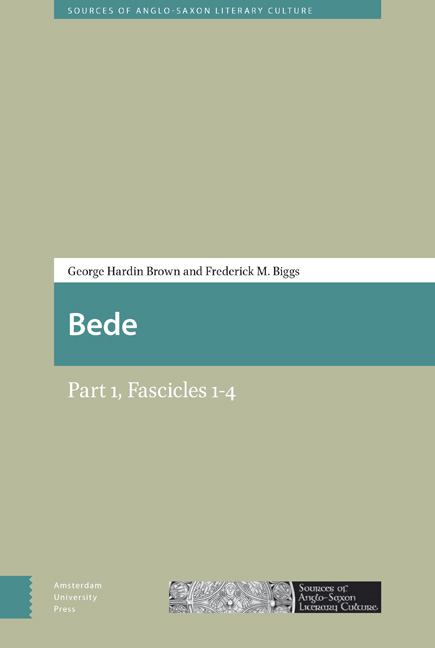Guide for Readers
Published online by Cambridge University Press: 02 February 2021
Summary
As part of the Sources of Anglo-Saxon Literary Culture [SASLC], the following entries on Bede conform to the structure of the reference work as a whole. Since they represent, however, the writings of only one author, fewer issues need to be addressed here. The minimal unit of SASLC is the entry, each of which discusses a particular text known in Anglo-Saxon England. Elsewhere in SASLC, entries may be gathered into larger, generic sets (such as APOCRYPHA; on the use of cross-references, see below), or they are, as here, found under a single author. While the structure of SASLC is alphabetical, individual entries within a major-author or a generic grouping may be organised in different ways, which will be explained at the beginning of these sections.
Each entry starts with a title and an abbreviation. For Anglo-Latin works, these are drawn from Michael Lapidge's Abbreviations for Sources and Specification of Standard Editions for Sources (1988; the bibliography at the end of the second fascicle is referenced by the author's name and the date of publication); for vernacular works, they are drawn from the Microfiche Concordance to Old English [MCOE]. As a result, SASLC is, on the whole, consistent with Fontes Anglo-Saxonici and the Toronto Dictionary of Old English, although at times we refer to more recent editions than the ones used in those works. Titles and abbreviations are then followed by references to standard scholarship on the text (see the list of abbreviations at the end of this Guide ), using item numbers if available (for example, CPL 1343 refers to the entry on DE NATURA RERUMin the Clavis Patrum Latinorum ) and page numbers if not. The next line designates the edition, which will be used throughout SASLC, that best represents what Bede wrote. So, for example, De natura rerum is edited on pages 180-234 of volume 123A of the Corpus Christianorum, Series Latina : CCSL 123A.180-234. References to the HISTORIA ECCLESIASTICA GENTIS ANGLORUMare to Michael Lapidge's Beda: Storia degli Inglesi (2010), and so to the third edition of volume 1 and the first edition of volume 2. On occasions when a work circulated in more than one version (for example, the metrical VITA CUTHBERTI) each is given its own entry.
- Type
- Chapter
- Information
- BedePart 1, Fascicles 1-4, pp. 11 - 16Publisher: Amsterdam University PressPrint publication year: 2017



